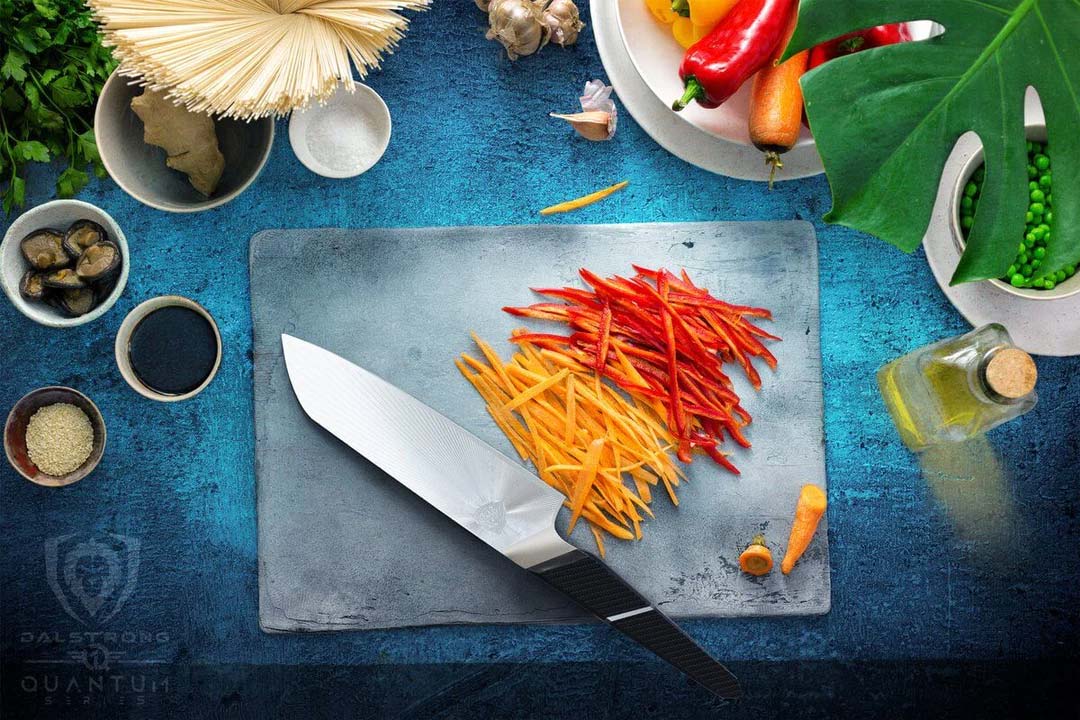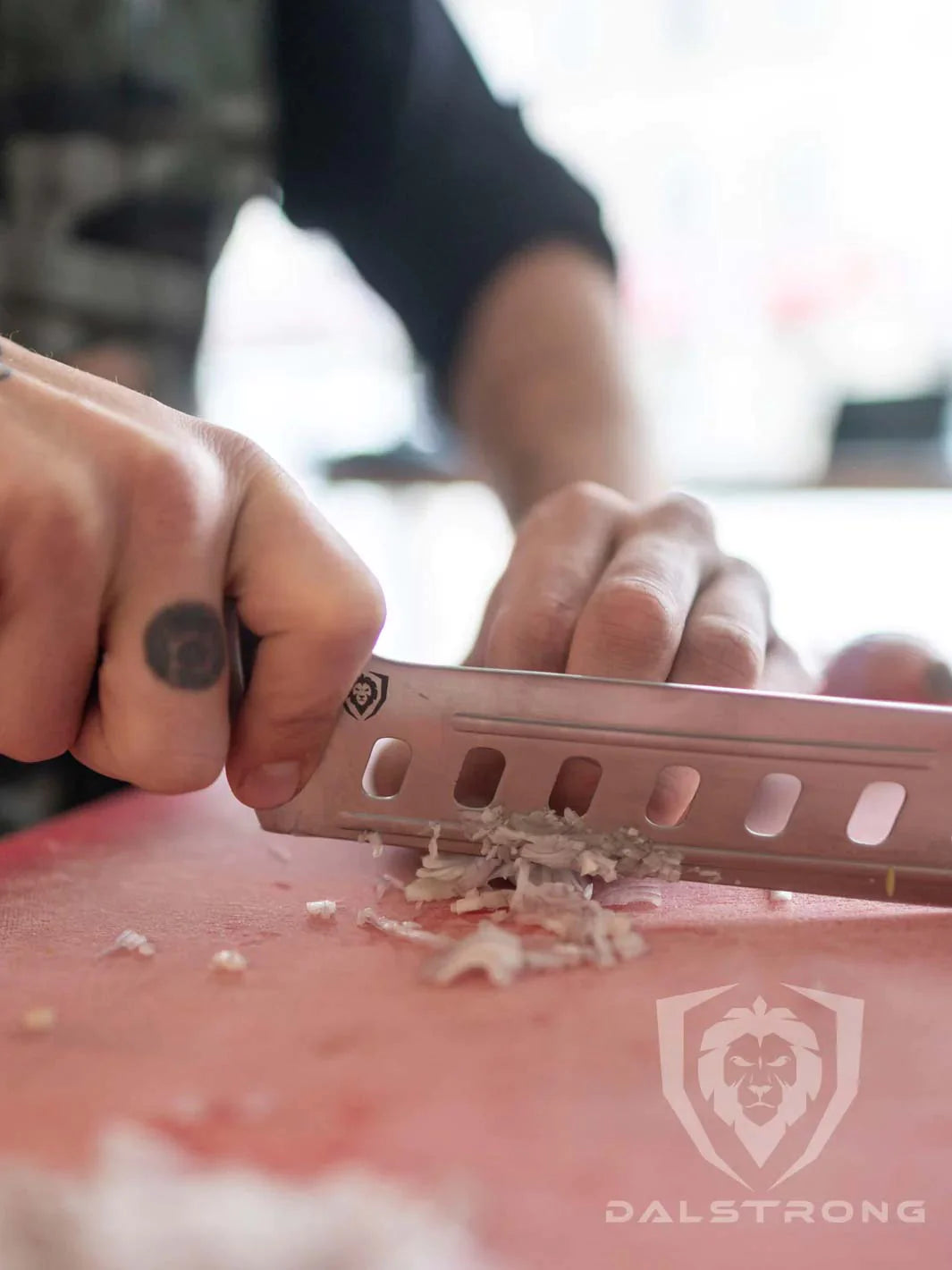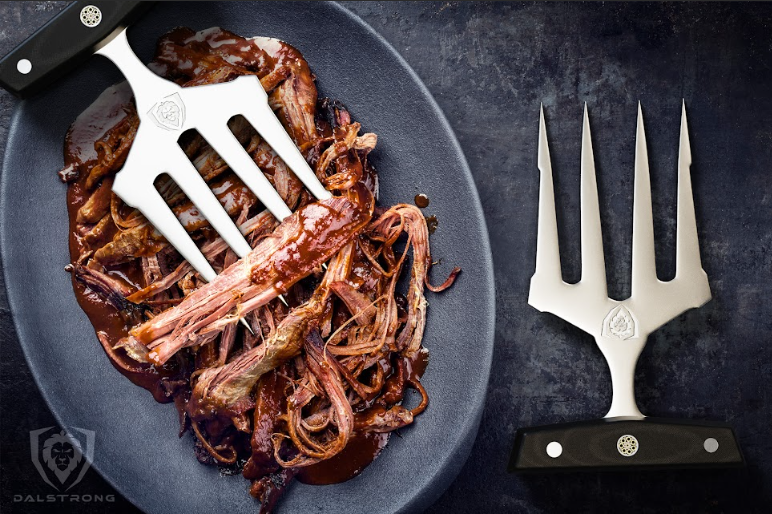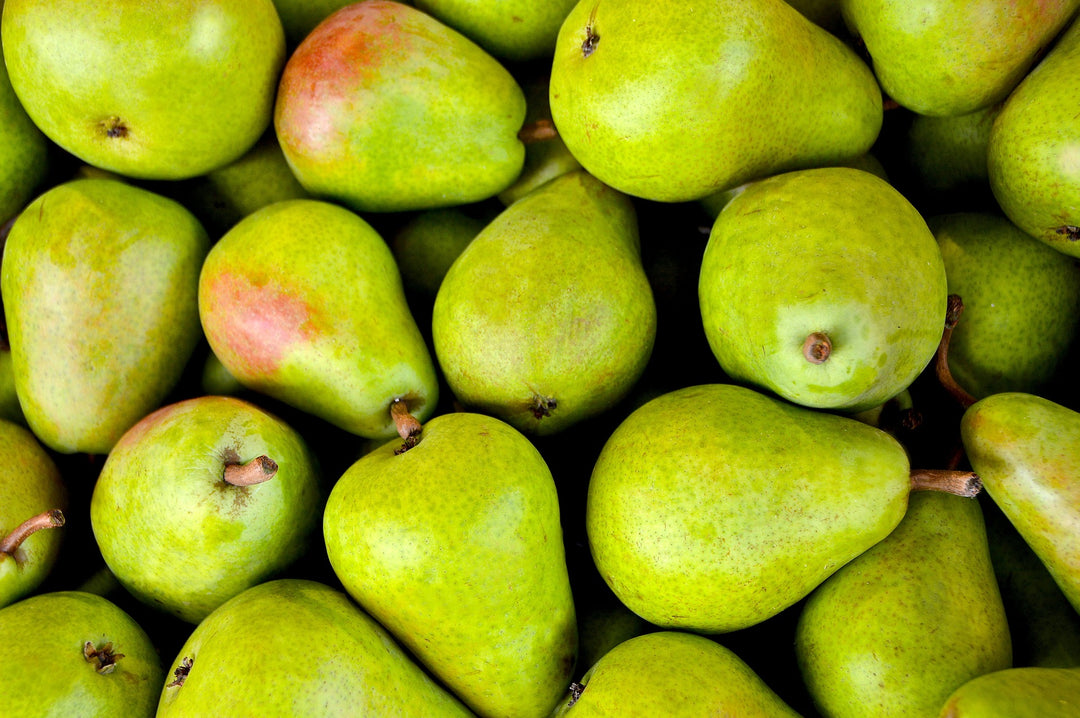How To Cut Mushrooms: A Guide
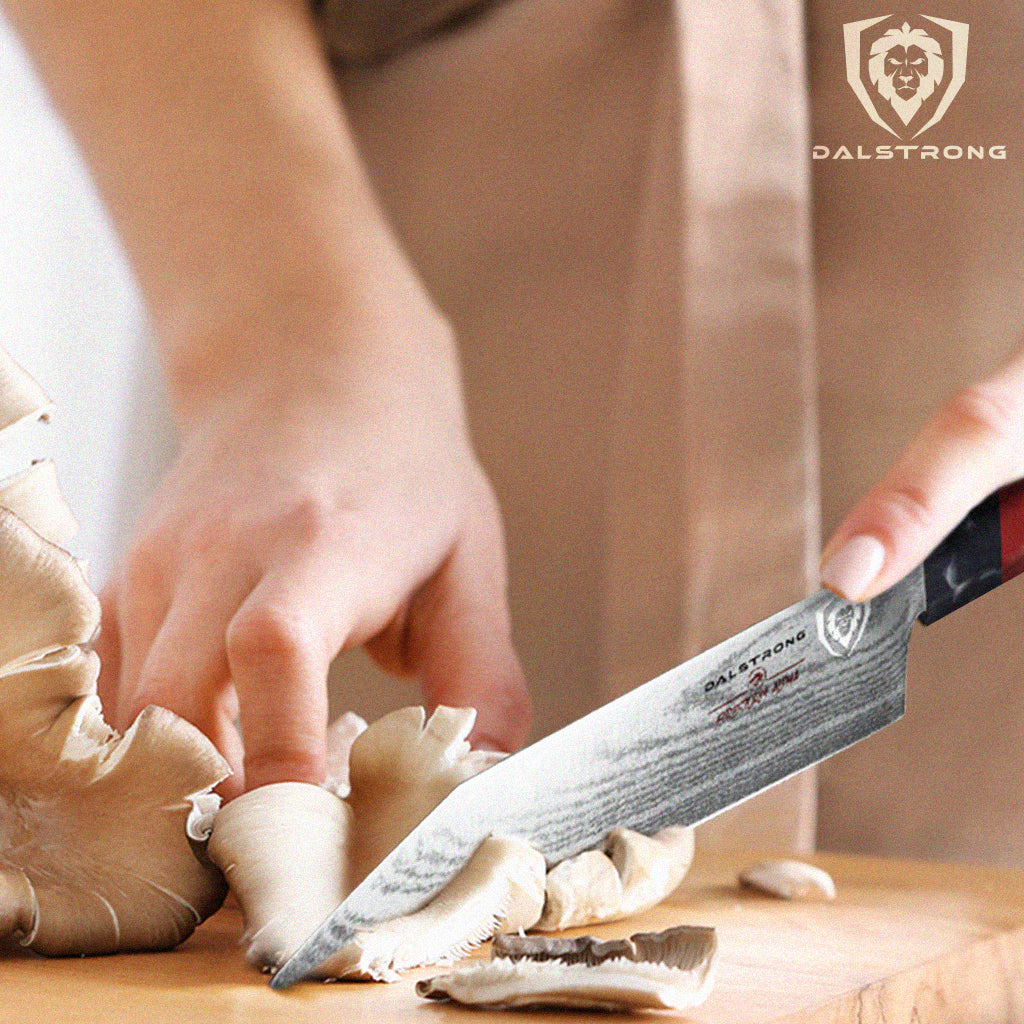 Chef's Knife 8"Firestorm Alpha Series | Dalstrong
Chef's Knife 8"Firestorm Alpha Series | Dalstrong
Quick Overview: How To Cut Mushrooms
- You'll need fresh mushrooms and a sharp knife.
- Examine the mushrooms for any dirt or debris. Utilize a brush or cloth to lightly clean mushrooms.
- If the stems are tough or discolored, trim them.
- Based on your recipe, you can choose to slice, chop, dice, or quarter the mushrooms.
- Adjust thickness depending on your preference and the recipe.
- Use the mushrooms immediately in your dish or store them in a paper bag.
A culinary adventure always starts with the fundamentals, and every aspiring cook needs to be skillful at cutting mushrooms. These tasty, flexible, and earthy fungi are utilized in a broad range of cuisines. But mastering the art of slicing and dicing them may make a world of difference.
Let's examine the straightforward yet essential processes that transform these basic components into mouthwatering treats.
1. Different Types Of Mushrooms
 12" Frying Pan Wok ETERNA Non-stick | Oberon Series | Dalstrong
12" Frying Pan Wok ETERNA Non-stick | Oberon Series | Dalstrong
Here's a list of different types of mushrooms.
Button Mushroom (Agaricus bisporus)
The button mushroom is one of the most common and widely consumed mushrooms worldwide. It has a mild, earthy flavor and a smooth, white cap. When mature, it opens up, revealing its gills underneath.
Portobello Mushroom (Agaricus bisporus)
This is essentially a mature version of the button mushroom. It has a larger cap, a meatier texture, and a more pronounced, rich flavor. Portobello mushrooms are frequently used as a meat substitute in vegetarian dishes.
Shiitake Mushroom (Lentinula edodes)
Originating from East Asia, shiitake mushrooms have a distinct, savory taste often described as "umami." They have a dark brown cap with a meaty texture, and are used in various Asian and international cuisines.
Oyster Mushroom (Pleurotus ostreatus)
These mushrooms have a light, delicate flavor and were given their name because they resemble oysters. They are available in a variety of hues, including as white, gray, and pink. Common uses for oyster mushrooms are stir-fries and soups.
Chanterelle Mushroom (Cantharellus cibarius)
Easily recognizable due to their vibrant golden-yellow color and distinctive funnel shape, chanterelle mushrooms have a delicate, fruity aroma and a slightly peppery taste. They're prized in gourmet cooking.
Morel Mushroom (Morchella spp.)
The unusual honeycomb-like appearance of morels makes them famous. They are regarded as a delicacy in many culinary traditions and have a deep, nutty flavor. They are frequently harvested in the wild.
Enoki Mushroom (Flammulina velutipes)
With long, small stems and tiny white caps, enoki mushrooms have a mild, slightly crunchy texture. They're commonly used in salads, soups, and Asian dishes.
Cremini Mushroom (Agaricus bisporus)
Similar in appearance to the button mushroom, cremini mushrooms are a bit browner and have a deeper, earthier flavor. They're a versatile choice for a wide range of dishes.
Maitake Mushroom (Grifola frondosa)
Also called "Hen of the Woods," maitake mushrooms have a frilly, layered appearance. They have a robust, earthy flavor and a firm texture. They're popular in Japanese and Chinese cuisines.
Porcini Mushroom (Boletus edulis)
The unusual honeycomb-like appearance of morels makes them known. They are regarded as a delicacy in many culinary traditions and have a deep, nutty flavor. They are frequently harvested in the wild.
Lion's Mane Mushroom (Hericium erinaceus)
Named for its shaggy appearance, lion's mane mushrooms have a delicate, seafood-like flavor. They're known for their potential health benefits and are gaining popularity in health-conscious diets.
Remember, while many mushrooms are edible and delicious, there are also toxic varieties. If you're uncertain about a specific mushroom, it's best to consult a knowledgeable expert or buy from reputable sources.
Read about the seven health benefits of mushrooms, here.
2. How To Clean And Prepare Mushrooms
 12" Sauté Frying Pan Silver | Oberon Series | Dalstrong
12" Sauté Frying Pan Silver | Oberon Series | Dalstrong
Here's a step-by-step guide on how to clean mushrooms and prepare different mushroom recipes.
- Gather Your Tools: Start by gathering what you'll need: fresh mushrooms, a clean kitchen towel or paper towels, a sharp knife, and a brush (a mushroom brush or a clean toothbrush works well).
- Inspect the Mushrooms: Take a close look at each mushroom. Check for any blemishes, dirt, or debris. If you see any discolored spots, trim them away with a knife.
- Dry Brushing: Use the brush to gently sweep away any visible dirt or debris from the mushroom caps and stems. A gentle brushing is usually enough for most varieties.
- Avoid Soaking: Mushrooms are like sponges and can absorb water quickly. Soaking them can lead to a watery, less flavorful dish. Alternatively, use a damp cloth or paper towel to wipe them clean.
- Wipe Clean: Dampen a cloth or paper towel slightly and gently wipe the surface of each mushroom. Pay extra attention to the gills and crevices where dirt might be hiding.
- Trim the Stems: If the stems are tough or woody, you might want to trim them. For most mushrooms, a quick slice with a knife at the base of the stem is all that's needed.
- Slice or Chop: Depending on your recipe, you can either slice the mushrooms thinly or chop them into larger pieces. Showcase your knife skill and be mindful of your fingers!
- Cook or Store: Once cleaned and prepped, you can use the mushrooms immediately in your chosen dish. If you're not using them right away, store them in a paper bag in the refrigerator to allow air circulation.
- Handling Delicate Varieties: For delicate mushrooms like enoki or oyster, you may only need to trim the roots and give them a quick rinse. Pat them dry lightly with a paper towel.
- Dispose of Any Spoiled Mushrooms: If you come across any mushrooms that are overly slimy, have a foul smell, or show signs of spoilage, it's best to discard them.
Remember, each type of mushroom may have slightly different cleaning needs, so always consider the specific variety you're working with. And while mushrooms are a wonderful addition to many dishes, please exercise caution and only consume varieties that are known to be safe and edible.
Check out our recipes for Pan-fried oyster mushrooms and Sauteed mushrooms.
3. How To Cut Mushrooms: Different Methods To Try
 Paring Knife 3.75" Shadow Black Series Dalstrong
Paring Knife 3.75" Shadow Black Series Dalstrong
Here are different methods for cutting mushrooms.
Slicing
Start by trimming the stem if it's tough or discolored. Then, place the mushroom cap-side down on your cutting board. Using a sharp and your expert knife skill, make even sliced mushrooms from one end to the other. Adjust the thickness to your preference.
Chopping
Begin by trimming the stem. Next, hold the mushroom cap-side down and make a few vertical cuts, then turn it and make horizontal cuts, creating small pieces. This method is great for dishes like stir-fries or soups.
Dicing
Similar to chopping, but with smaller, more uniform pieces. Trim the stem and make even vertical and horizontal cuts. This results in tiny, uniform cubes, perfect for sauces or toppings.
Quartering
This method is especially useful for larger mushrooms like portobellos. Trim the stem, then cut the cap into four equal sections. This creates hearty pieces that retain their shape in cooking.
Scooping
If you want to stuff mushrooms, start by removing the stem. Then, use a spoon to gently scoop out a bit of the inner flesh, creating a hollow space for your stuffing.
Mincing
For recipes that require finely chopped mushrooms, start with the slicing method. Then, gather the sliced mushrooms and finely chop them into small, even pieces. This is great for incorporating mushrooms into sauces and fillings.
Bias Slicing
This method involves slicing the mushrooms at an angle instead of straight across. It can create visually appealing, elongated pieces that work well in salads or as garnishes.
Cross-cutting
After slicing the mushrooms, make a few crosswise cuts. This creates smaller, bite-sized pieces that cook quickly and evenly.Remember all the time to use a sharp knife when cutting mushrooms. A dull knife can make the process more challenging and can potentially be dangerous. Also, be mindful of your fingers and keep them tucked in while cutting. With practice and enhancing your knife skill, you'll become more confident and efficient in handling mushrooms with your knife. Happy cooking and enjoy different kinds of mushrooms recipe.
4. Recommended Dalstrong Tools You Can Use
1. Corner Cutting Board Natural Teak Wood
Introducing the Corner Cutting Board crafted from exquisite Natural Teak Wood, a testament to Dalstrong's quest to both functionality and aesthetic appeal in culinary tools. This artisanal cutting board is designed to provide a seamless blend of form and function for discerning home chefs and culinary enthusiasts.
PROS:
- The choice of Teak Wood brings a touch of natural elegance to your kitchen. Known for its durability and resistance to moisture, teak is a favored material in high-quality kitchenware.
- The robust construction ensures that this cutting board will stand the test of time, even under heavy use. It's built to be a reliable kitchen companion for years to come.
- The unique corner shape is more than just an aesthetic choice. It maximizes space efficiency, allowing for more workspace in your kitchen, and making it a versatile tool for various culinary tasks.
- Teak wood is known for its gentle treatment of knife edges. It helps maintain the sharpness of your knives, ensuring they stay in top condition for longer periods.
- The natural oils in teak wood make it resistant to staining and odors. A fast clean with warm water and mild soap is usually all that's needed to keep it looking brand new.
CONS:
- Teak wood is dense and can make this cutting board relatively heavy. While this adds to its stability, it might not be the most portable option for some users.
Step into the kitchen with confidence and style, courtesy of the American Legend Blue Denim Professional Chef's Kitchen Apron by Dalstrong. Crafted with both culinary expertise and a keen eye for design, this apron embodies the spirit of a seasoned chef, offering not only protection but also a touch of timeless flair.
PROS:
- The choice of blue denim as the primary material not only gives this apron a rugged, stylish look but also provides exceptional durability. It's built to withstand the rigors of a professional kitchen.
- Designed with the chef's comfort in mind, the adjustable straps ensure a custom fit for all body types. This means less strain during long hours in the kitchen.
- The apron features strategically placed pockets, providing convenient storage for essential tools and utensils. This keeps everything you need within arm's reach, enhancing workflow efficiency.
- The classic denim design is not only fashionable but also versatile. Whether you're a passionate home cook or a professional chef, this apron is a suitable companion for a wide range of culinary endeavors.
- Cleaning up after a busy cooking session is a breeze. The denim material is known for its resistance to stains and can be easily spot-cleaned or machine-washed for a fresh start.
CONS:
- The American Legend apron is primarily available in blue denim, which, while classic and stylish, may not suit all personal tastes or kitchen color schemes.
3. Kiritsuke Chef's Knife 8.5" Shogun Series ELITE | Dalstrong
The Kiritsuke Chef's Knife 8.5" from Dalstrong's Shogun Series ELITE is meticulously crafted to embody precision, balance, and artistry. This knife is more than a kitchen tool; it's a testament to the fusion of tradition and innovation in the world of culinary cutlery.
PROS:
- Combining the features of a traditional chef's knife and a Japanese kiritsuke, this blade is a versatile powerhouse. It excels in slicing, dicing, chopping, and precision work, making it a true multi-purpose tool.
- The precision-honed edge is hand-finished to a staggering 8-10 degrees per side, ensuring exceptional sharpness. This results in clean, effortless cuts through a wide range of ingredients.
- The knife's stunning design is a harmonious blend of form and function. The G10 handle gives a safe and secure grip, while the mosaic pin and beautiful Damascus pattern offer a touch of elegance.
- The blade is crafted from high-carbon Japanese AUS-10V steel, known for its exceptional hardness, corrosion resistance, and edge retention. This ensures the knife remains a reliable companion for years to come.
CONS:
- While the Kiritsuke Chef's Knife is incredibly versatile, it may not be the ideal choice for cooks who prefer very specific, specialized knives for individual tasks.
4. Santoku Knife 7" Firestorm Alpha Series | Dalstrong
The Santoku Knife 7" from Dalstrong's Firestorm Alpha Series, is a blade that harmonizes the precision of Japanese cutlery with the power and durability of modern craftsmanship. With its sleek design and exceptional performance, this knife is a must-have tool in every kitchen.
PROS:
- The Firestorm Alpha Series Santoku Knife is a testament to Dalstrong's commitment to merging aesthetics with functionality. The blade's striking design complements its robust construction, promising a powerful cutting experience.
- The Santoku design, with its flat edge and shorter, wider blade, offers exceptional versatility. It excels in tasks like slicing, dicing, and chopping, while the 10CR15MOV High-Carbon Steel ensures the blade's longevity and sharpness.
- The knife features an ergonomic handle made of G10, a material known for its resistance to moisture and impact. This provides a secure, comfortable grip even in demanding kitchen conditions.
- The blade boasts an incredibly sharp edge, honed to perfection. This allows for clean, precise cuts every time, making it a reliable companion for a wide range of culinary tasks.
CONS:
- While the Santoku's design is versatile, it may not be the go-to choice for tasks that require the pointed tip of a traditional chef's knife.
5. Utility Knife 6" Shogun Series ELITE | Dalstrong
The Utility Knife 6" from Dalstrong's Shogun Series ELITE, is a blade that epitomizes the perfect blend of precision and versatility. Crafted with meticulous attention to detail, this knife is poised to become an indispensable tool in the hands of culinary enthusiasts and professional chefs alike.
PROS:
- With its compact size and nimble blade, the Utility Knife excels in a wide range of tasks. From slicing and dicing to precision work, it's a versatile companion for any kitchen.
- The blade is painstakingly sharpened to a precise angle, ensuring exceptional sharpness and edge retention. This guarantees effortless and precise cuts with every use.
- Crafted from high-carbon Japanese AUS-10V steel, this Utility Knife not only offers impressive hardness but also remarkable corrosion resistance. This means it's not only sharp but also durable and easy to maintain.
CONS:
- Due to its shorter blade length, the Utility Knife may not be the best choice for tasks that require longer strokes, such as slicing larger roasts.
5. Frequently Asked Questions
Do you have to cut stems off mushrooms?
No, you don't have to cut the stems off mushrooms. In fact, many mushroom varieties have edible stems and can be used in cooking. However, some mushrooms, like shiitake, may have tough stems that are better removed. Ultimately, it depends on the specific type of mushroom and your recipe preferences.
How do you slice mushrooms step by step?
Clean mushrooms with a brush or damp cloth to remove any dirt.
Trim the tough or discolored parts of the stems.
Place the mushroom cap-side down on a cutting board.
Use your knife skill to make even slices from one end to the other.
Adjust thickness according to your preference.
Do you have to peel mushrooms?
No, you generally don't need to peel mushrooms. The skin of most mushroom varieties is edible and contains a good amount of nutrients and flavor. Cleaning them with a cloth or brush to remove any dirt is usually sufficient. However, if you find the skin tough or unpleasant in a particular recipe, you can trim it, but it's not a common practice.
What is the best tool to cut mushrooms with?
The best tool to cut mushrooms is a sharp chef's knife. Its broad, sturdy blade allows for precise slicing or chopping, while the sharp edge ensures clean mushrooms cuts. A knife with a comfortable handle provides better control. A good quality paring knife or a mushroom-specific knife can also be effective for certain tasks, like trimming stems or delicate slicing.








































































































































































